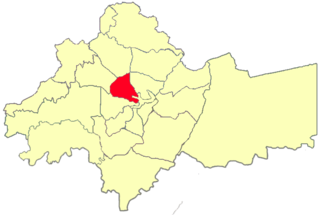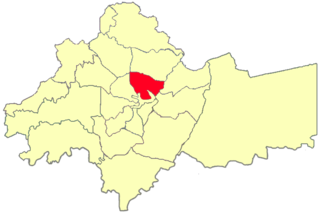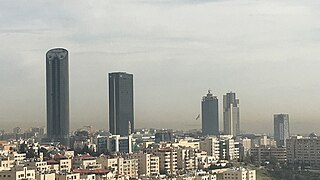
Amman is the capital and the largest city of Jordan, and the country's economic, political, and cultural center. With a population of 4,061,150 as of 2021, Amman is Jordan's primate city and is the largest city in the Levant region, the fifth-largest city in the Arab world, and the tenth-largest metropolitan area in the Middle East.

As-Salt, also known as Salt, is an ancient trading city and administrative centre in west-central Jordan. It is on the old main highway leading from Amman to Jerusalem. Situated in the Balqa highland, about 790–1,100 metres above sea level, the city is built in the crook of three hills, close to the Jordan Valley. One of the three hills, Jabal al-Qal'a, is the site of a 13th-century ruined fortress. It is the capital of Balqa Governorate of Jordan.

The Amman International Stadium is a stadium in Al-Hussein City, Amman, Jordan. It is the largest stadium in Jordan. The stadium was built in 1964 and opened in 1968. It is owned by the Government of Jordan and operated by the Higher Council of Youth. It is also the home stadium of the Jordan national football team and Al-Faisaly SC. It has a current capacity of 17,619 spectators.
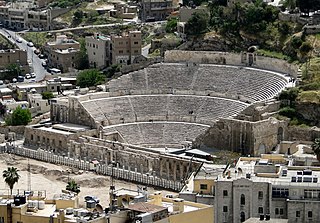
Roman Theatre of Amman is a 6,000-seat, 2nd-century Roman theatre. A famous landmark in the Jordanian capital, it dates back to the Roman period when the city was known as Philadelphia. The theatre and the nearby Odeon are flanking the new Hashemite Plaza from the south and the east respectively, while the Roman Nymphaeum is just a short stroll away in north-westerly direction.
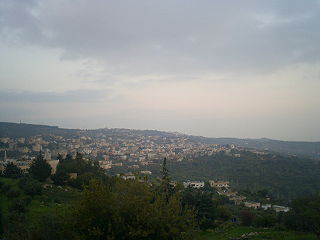
Mahis is a town in the Balqa Governorate northwest from the governorate's capital Salt, and 10 kilometers (6.2 mi) west of Amman. Its population was 17,754 in 2015. Most of the population of Mahis descends from the Abbadi tribe.. The mountainous town is located at over 800 meters (2,600 ft), with views on the Jordan Valley, West Bank with Jerusalem's walls visible on the horizon. Mahis is known for its orchards and its numerous water fountains and springs, notably the Fountain of Mahis.
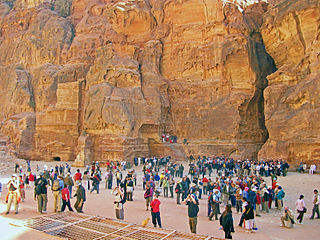
Jordan is a sovereign Arab state in the Middle East. The capital, Amman, is Jordan's most populous city as well as the country's economic, political and cultural centre.

Jordanian art has a very ancient history. Some of the earliest figurines, found at Aïn Ghazal, near Amman, have been dated to the Neolithic period. A distinct Jordanian aesthetic in art and architecture emerged as part of a broader Islamic art tradition which flourished from the 7th-century. Traditional art and craft is vested in material culture including mosaics, ceramics, weaving, silver work, music, glass-blowing and calligraphy. The rise of colonialism in North Africa and the Middle East, led to a dilution of traditional aesthetics. In the early 20th-century, following the creation of the independent nation of Jordan, a contemporary Jordanian art movement emerged and began to search for a distinctly Jordanian art aesthetic that combined both tradition and contemporary art forms.

Wadi Al-Seer or Wadi as-Seer is an area in the Greater Amman Municipality named after a prehistoric queen that ruled the area, Queen Seer. It consists of ten neighborhoods, some of which are residential, other commercial, or both.

Wadi Abdoun Bridge or the Kamal Al-Shair Bridge is a bridge in Amman, Jordan. The only cable-stayed bridge in the country, it crosses the Wadi Abdoun. The building of the bridge commenced on 14 December 2002, and it was opened on 14 December 2006 and was built by Larsen & Toubro Limited, an Indian multinational company. It is part of Amman's Beltway project and links South Amman to the 4th Circle and Zahran Street. Since it was opened it has witnessed over 70 cases of attempted suicide.

The Amman Citadel is an archeological site at the center of downtown Amman, the capital of Jordan. The L-shaped hill is one of the seven hills (jabals) that originally made up Amman.

The 2016 FIFA U-17 Women's World Cup was the fifth edition of the FIFA U-17 Women's World Cup, the biennial international women's youth football championship contested by the under-17 national teams of the member associations of FIFA. The tournament was held in Jordan from 30 September to 21 October 2016.
The following is a timeline of the history of the city of Amman, Kingdom of Jordan.
The 7Hills Skatepark is a 650 sq. meter concrete skatepark located at Samir Rifai Park in downtown Amman, Jordan named for the seven hills that the city is built on.
The Armenian Catholic Patriarchal Exarchate of Jerusalem and Amman is the missionary pre-diocesan jurisdiction of the Armenian Catholic Church sui iuris in the Holy Land (Palestine/Israel) and (Trans)Jordan.

Jordan Public Security Directorate, or PSD is a public security agency of the Hashemite Kingdom of Jordan, which lies under the jurisdiction of the country's Ministry of Interior.

The ʿAin Ghazal statues are a number of large-scale lime plaster and reed statues discovered at the archeological site of ʿAin Ghazal in Amman, Jordan, dating back to approximately 9000 years ago, from the Pre-Pottery Neolithic C period. A total of 15 statues and 15 busts were discovered in 1983 and 1985 in two underground caches, created about 200 years apart.












